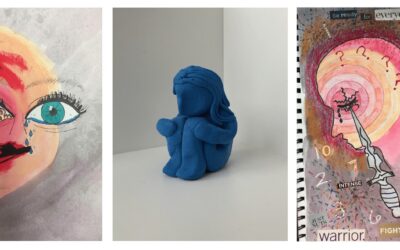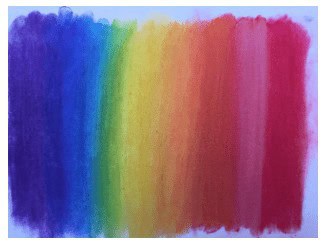When Ashley was a 20-year-old college student, she developed a headache behind her left eye. At first, she didn’t think much of it: it was a headache, it would pass. Except it didn’t. For four years, Ashley struggled to cope with her pain, and the depression it exacerbated, seeing medical professionals from internists to chiropractors to naturopaths to neurologists to gynecologists to ophthalmologists to psychiatrists. Eventually, a headache specialist referred her to a large university hospital, where she was finally diagnosed with a spinal CSF leak. Even with the relief of a diagnosis, her leak has been tricky to treat: blood patching has helped but not cured her, and over the past four years, Ashley has had to learn to find a balance between stabilizing her mood and decreasing her pain, as many times helping one worsens the other. One thing that has proved to be very helpful to her is turning to art as a creative outlet. “I can’t take my pain away,” she says, “but I can express it through art.” And through sharing that art, she can let other people know that they are not alone. I spoke with Ashley just two weeks after her latest round of epidural blood patching, as she recovered at home.
Is art something you’ve always done, even before you experienced a spinal CSF leak?
Yes, I’ve always liked art.
Did your interest in art change when you got sick?
It became more of a way of expressing myself, rather than making things to give to people—obviously, I’m not going to give people my headache pictures. That’s more for me. [But] I have dealt with depression for ten years now, and I do a lot of art for that as well.
How does making art help you cope?
It helps being able to see it. Because the pain’s just always there, invisible. Being able to put that onto paper does something. There’s no medication that helps my pain, so in a way the art becomes my medicine. Also, I don’t really tell people that my head hurts. The only people that can tell when I’m hurting are my parents, they say they can see it in my eyes. I never mention it to anyone, as I don’t like that pain to be my identity. Everyone has headaches, but my headache is different than other people’s headaches, and just saying, “My head hurts,” doesn’t really tell people much. But when they can see the art I make, I think that speaks louder than words.
Do you plan out your art projects or is it more spur-of-the-moment?
I don’t really plan it. Since it’s about expressing my feelings, it sort of just comes to me in the moment. Normally my head’s hurting and of course that pain is on my mind, and so then I’ll start doodling and that’ll turn into an art project. I often use multiple types of media to create a piece. For example, I may start with drawing and then add watercolor, oil pastels, images I found in magazines, 3D paint, etc. I just keep adding to express how I feel in the moment. My headaches aren’t simple, so neither is my art. The complexity in my pieces reflects the complexity of my CSF leak.
Does the physical process of making art while in pain help you?
It helps distract me. I find that when I am sitting upright to work on art, I’m able to cope with my pain better. I’d say that I get lost in the art. Suddenly time passes by a lot faster and my pain is no longer controlling me. [Also, for example,] my pain is located on my left eye. Usually I draw the pain on the left eye in my art, but if my head is really hurting, I draw my reflection, so I am looking at my pain. There is something very therapeutic about that. I’m not sure how to put the feeling in words, but it changes me in a good way. And then also the colors I use are a really big part of it. I can’t see my headache, I can only feel it; but I can use color to express the pain. I always wish my doctors would let me do a pain scale that was in color instead of numbers! I can give a color to my pain much easier than I can give a number to it.
Yes, it’s so hard to quantify! I love the idea of a color-based pain scale. What would that look like for you?
Many people experiencing a spinal CSF leak aren’t able to tolerate being upright. How do you actually do your art? What is the physical process of making art like for you?
Yes, people with a spinal CSF leak spend a lot of time lying down, which is not the best position for creating art. However, I have found some ways to still express myself through art without sitting up. Sometimes I’ll just sketch with pencils, but the easiest art for me to do is making sculptures. I like to use Model Magic because it is light, does not need to bake, can be reused if kept sealed, and does not make my hands dirty.
Do you have any advice for people who may be dealing with a spinal CSF leak?
Patience is key. Art is a great way to cope, and sharing that art has been really helpful for me, too. I’m quiet, and so my art has been a way to show people what I’m experiencing.


